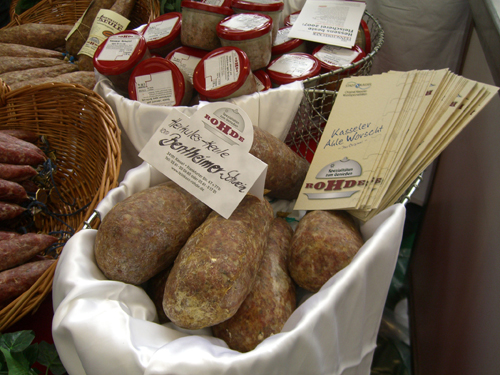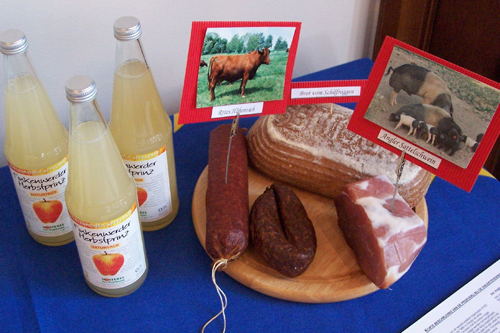Introduction
Marketing is an important part of the process to find ways to finance Ark and Rescue Centres (A&RCs). A&RCs should be as self-sufficient as possible, as dependence on state subsidies can be dangerous in times of cutback. Besides marketing the actual products from rare breeds like milk, meat and wool, it is possible to market services such as landscape management, promoting tourism and education. The marketing strategies strongly depend on the type of A&RC, its location and market potential, end customers and outlets. These marketing strategies should be seen as general guidelines for marketing, labelling and financing.
After identifying possible A&RCs in the regional areas with the focal points “Educational A&RC“, “Farm A&RC“, “Rescue station” or “Quarantine station” (see Guidelines for Characterisation) an overview of the individual marketing possibilities is necessary.
- The various European countries have vast difference in marketing, culture, income, purchasing parity and consumer behaviour, which results in a complex and diverse starting point for setting out generally accepted guidelines.
- In spite of this it is possible to isolate general consumer requirements and general marketing tools for the producer.
To promote product marketing SAVE Foundation is, within the framework of ELBARN, currently developing a trademark as a general tool to support rare breeds (in the long run such a trademark should become an EU label and also support products from plants). As certification is a crucial point for a small organisation, the new trademark will be an add-on to labels already in use.
The following guidelines were set in motion by the “Work Group 4: Marketing of Products and Services” at the ELBARN Workshop in Kutna Hora, Czech Republic in February 2008. A small working group, made up of members of the project partner organisations and other interested colleagues, have continued the process that has led to these guidelines.
 |
|
photo: A. Feldmann
Traditional products made from local breeds connect consumers to their local culture.
|
Product Marketing
- search for a broad marketing base
- pay attention of the continuity on every level
- combine diverse marketing strategies: preferably direct marketing from farm shop but search for partners, e.g. also sell products such as bread, milk products, fruit and vegetables from partners
- combination of various products to obtain added value
- search for contact to the high class restaurants (e.g. marketing via http://www.rungisexpress.com/)
- through ELBARN it can be arranged that interested farms participate in an online webshop portal (e.g. www.agroviva.de ) where products can be sold directly (cost: 20€/month for 50 participants),
- promote existing initiatives (see Annex 1)
- use the knowledge gained by other farmers (see Annex 2)
- check funding for assistance with local marketing strategies
- link agriculture with biodiversity! (target consumer group: Lifestyle of health and sustainability [LOHAS])
- use USPs (Unique selling points) for different levels: e.g. Grey Steppe cattle on regional level and Camarque horses on landscape level
- make contact with existing eco labels and other associations
- a responsible person should be appointed for each area to coordinate the whole marketing scheme and activities to promote A&RCs
Tourism & Education
- support tourism with information campaigns (image, products, riding, observation, visits, product tasting)
- in tourism and education the focus lies in raising awareness for the importance of conserving rare breeds and the positive aspects in their use as preserver of cultural and natural heritage
- promote farm park visits for children and adults through Arca-Net, but also by advertising, course materials for schools, information leaflets etc. Prepare lesson plans for teachers to use in schools
- identify suitable breeds for landscape management (see Annex 3)
Labelling
- make use of the new trademark for small scale, extensive production from local breeds and plant varieties using traditional manufacturing and respecting animal welfare
- respect the conditions for the trademark/label and make sure that certification via a national certifying body is guaranteed
- make sure that the labelled products really come from small scale, extensive production from autochthonous and locally adapted breeds
- help to promote the trademark by using it on your A&RCs products
- look for cooperation with regional, national or international institutions and programmes (e.g. restaurants, “Mountain Farmer” programmes, biosphere products, Slow Food)
- products should be traceable with a comprehensible animal/farm/product number “from farm to fork”
- identify possible institutions and/or programmes for cooperating with the labelling of an A&RC label
- identify regional, national or European-wide institutions who can support nature conservation with rare breeds
Providing services
- identify suitable breeds for services (pack horse/donkey, grazing, cultivator, etc)
- promote the using of animals for services (see Annex 3)
- these services should be hired out on a contractual basis and be paid for
 |
|
photo: A. Feldmann
Traditional products from the Swabian-Hall Pig – Reintroducing traditional breeds into agricultural production allows farmers to fill an
exclusive product-niche.
|
Recommended Action
Marketing is crucial for the sustainable conservation of rare breeds and the financing of A&RCs. An overall aspect is the development of a label which could be applied to A&RCs in the whole of Europe. A label will add value for the producer and give consumers confidence in the product. It is also necessary to connect regional, national and European marketing initiatives and also lobby for additional funds from other, interested institutions. On a more regional level the first step is to identify the different kinds of A&RCs and their location and then develop a special marketing scheme for one or more of these centres.
The ELBARN A&RCs may be supported by providing a webshop utility (e.g. www.agroviva.de) for promoting product information. This must be accompanied by education of tourists and the local population to promote the importance of conserving rare breeds. This conservation is accompanied by positive aspects in their use, as preservers of cultural and natural heritage.
A list of “best practise” examples can be used to provide information of how to establish a successful marketing idea to the interested A&RCs. This might be in the field of product marketing, tourism or providing services like grazing projects (www.grazinganimalsproject.org.uk) for landscape management. These examples are online in form of a “Best Practise List” for marketing products, tourism & education and services: www.elbarn.net
A&RCs focused on “Rescue” or “Quarantine” have limited opportunities for product marketing as they need to keep space free for emergencies and animals stay there only for a short period. Therefore, lobbying for rescue funds on regional, national and/or EU level should be pursued.
Finally, through marketing, it must be possible that long-term sustainability for the conservation of old and endangered breeds as a source of valuable Animal Genetic Resources is achieved.
 |
|
photo: Oetmann
Consumers like to “know the story” behind what they are buying – selling
farm products makes conservation breeding fi nancially sustainable.
|
Conditions for use of trademark by
ELBARN A&RCs
(These are divided into “Basic” and “Additional” conditions so that regional differences can be allowed for)
Basic Conditions (all must be fulfilled):
- the livestock must belong to an autochthonous breed (or breed traditional to that region)
- livestock must be kept in a free range, extensive environment
- the production must be local, extensive and small scale
- livestock must be a valuable part of the cultural heritage
- specifications for Animal welfare must be respected, see:
http://ec.europa.eu/food/animal/welfare/index_en.htm. http://ec.europa.eu/food/animal/welfare/slaughter/index_en.htm,http://ec.europa.eu/food/animal/welfare/transport/index_en.htm
- participating A&RCs should run a herd book or should be a member of a breeding organisation which runs a herd book
Additional Conditions (at least half must be fulfilled):
- The livestock should be pure breeds and that should be documented
- quality should be guaranteed (seasonal fluctuations are accepted for natural products but feeding guidelines have to be respected)
- traditional, artisan processing should be used
- the distribution should respect rules of fair trade
- manufacturing should regard as minimum EU Bio regulations (Council Regulation (EC) No 967/2008 of 29 September 2008 amending Regulation (EC) No 834/2007 on organic production and labelling of organic products
Useful Websites
www.agroviva.de
www.elbarn.net
www.grazinganimalsproject.org.uk
www.rungisexpress.com
http://ec.europa.eu/food/animal/welfare/index_en.htm
http://ec.europa.eu/food/animal/welfare/transport/index_en.htm
http://ec.europa.eu/food/animal/welfare/slaughter/index_en.htm
http://eur-lex.europa.eu/LexUriServ/LexUriServ.do?uri=CELEX:32008R0967:EN:NOT
Annex 1: Best practise - Tourism/Education
See: www.arca-net.info
Arca-Net is both travelling guide and information portal
Rare and endangered livestock breeds and old cultivated plants may have disappeared from agricultural production units but they continue to live on numerous Arkfarms, livestock parks, open-air museums and other institutions.
Arca-Net makes these institutions known and promotes visits. Moreover, Arca-Net offers simple background information and raises awareness of the need for conservation.
Publicly accessible institutions with rare breeds and/or endangered cultivated plants use this internet portal to inform the wider public about their establishment and to encourage visits. They can also use the portal to advertise their products.
The inclusion into Arca-Net is free.
Arca-Net today
Arca-Net is available in English, French, German and Italian. It contains today (February 2009) over 300 institutions in 34 European countries from Iceland to Malta North-South and from the Azores to Ukraine West-East.